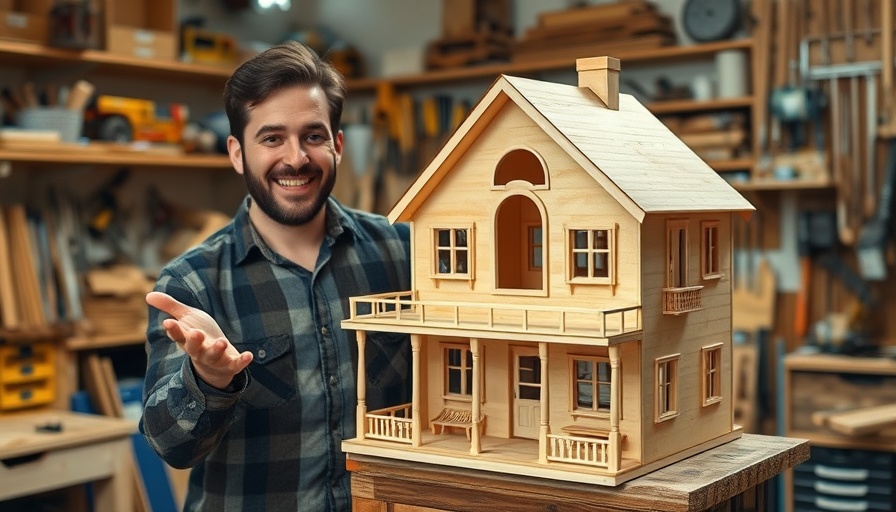
The Art of Building a Dollhouse in Just One Day
In a stunning display of creativity and craftsmanship, hosts Adam and Juliet take on the incredible challenge of constructing a dollhouse from scratch in just twelve hours. This DIY adventure is not only entertaining but also serves as a reminder of the joy that comes from hands-on projects, fostering connections between generations. The thrill of building brings a sense of accomplishment while sparking imagination in both the creators and future generations playing with the finished product.
In '12 Hour DIY Challenge: Building A Doll House!', Adam and Juliet embark on an ambitious quest to create a dollhouse, igniting deeper reflections about creativity and family bonding.
Understanding the Inspirations Behind DIY Projects
DIY projects like Juliet and Adam's dollhouse are more than mere building exercises; they are a reflection of personal creativity, family values, and memories waiting to be made. The design features mid-century aesthetics that appeal to contemporary tastes, proving that classic styles can be timelessly relevant. Every piece designed and crafted holds a story, carrying the essence of the individual's or family's personality, thereby enhancing its value beyond mere material.
A Mid-Century Marvel: Crafting with Intention
From the moment the first sheet of ply was cut, each decision made during the building process was intentional, leading to a unique dwelling that embodies both function and style. The dollhouse showcases features like an open-plan layout, ensuring spaciousness while offering the ability to furnish it with unique accessories. This thoughtful approach to design reflects current household trends where multifunctional spaces and aesthetic appeal meet functionality.
Lessons in Creativity: Overcoming Challenges
Building a dollhouse is not without its share of challenges, much like any creative endeavor. Adam and Juliet's journey exemplifies problem-solving at its best, emphasizing the importance of adapting strategies as unexpected situations arise. Whether it’s determining how to fit together quirky angles or organizing how to apply finishes, their process teaches valuable lessons about perseverance and ingenuity that are applicable in daily life and work.
The Importance of Family Involvement in DIY Projects
The hands-on nature of building a dollhouse invites involvement from family members, making it a collaborative effort that breeds closeness. As children like Jack and Jill play and interact with the finished results, they benefit from creative thinking and teamwork skills. Such bonding experiences create lasting memories and can even ignite a passion for DIY projects that extends into adulthood, nurturing a future generation that values creativity and craftsmanship.
Adding the Finishing Touch: Decor and Aesthetics
No home is complete without a touch of personality. In the case of the dollhouse, this involved meticulous styling, where every detail counts—from the choice of rug textures to the placement of furniture. By engaging in decor, families not only enhance their designs but also learn the art of curating spaces that resonate personally. This aspect of the project encourages participants to consider color theory, spatial arrangements, and thematic consistency.
Culinary Creativity: The Perfect Picnic to Complement the DIY Spirit
Just when the excitement of crafting a dollhouse peaks, Adam delivers gourmet ideas for a spring picnic that align perfectly with the vibe of creativity. These simple yet sophisticated recipes, like the sticky fingers chicken sandwich, exemplify how passion extends beyond crafting into cooking, encouraging families to share time together in various creative outlets. This holistic approach to creativity intertwines the essence of DIY with food, encouraging a more inclusive experience.
Building for the Future: The Case for Creativity in Homes
The results of Adam and Juliet's ambitious project remind us that the art of building—and crafting—extends beyond just physical structures. By fostering creativity, families can strengthen ties and create unique spaces that serve as symbols of love and tradition. As trends shift towards personalization and self-expression, these DIY endeavors inspire families to explore their creative potential and imbue their homes with character.
Ultimately, whether you’re scaling the heights of DIY projects or enjoying a perfect picnic, the essence remains the same: enrich your life through creativity, connection, and love. So gather your tools and your loved ones, and let your imagination guide your next project!
 Add Row
Add Row  Add
Add 




Write A Comment